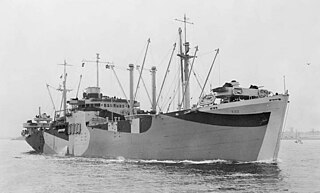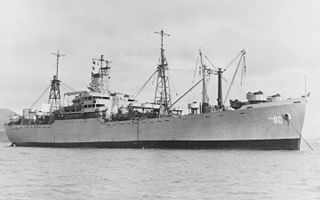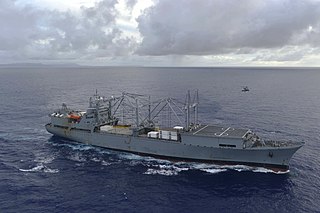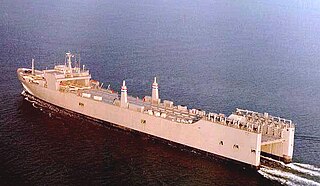
Type C1 was a designation for small cargo ships built for the United States Maritime Commission before and during World War II. Total production was 493 ships built from 1940 to 1945. The first C1 types were the smallest of the three original Maritime Commission designs, meant for shorter routes where high speed and capacity were less important. Only a handful were delivered prior to Pearl Harbor. But many C1-A and C1-B ships were already in the works and were delivered during 1942. Many were converted to military purposes including troop transports during the war.

Type C2 ships were designed by the United States Maritime Commission (MARCOM) in 1937–38. They were all-purpose cargo ships with five holds, and U.S. shipyards built 328 of them from 1939 to 1945. Compared to ships built before 1939, the C2s were remarkable for their speed and fuel economy. Their design speed was 15.5 knots (28.7 km/h), but some could make 19 knots (35 km/h) on occasion. The first C2s were 459 feet (140 m) long, 63 feet (19 m) broad, and 40 feet (12 m) deep, with a 25-foot (8 m) draft. Later ships varied somewhat in size. Some, intended for specific trade routes, were built with significant modifications in length and capacity.
Lykes Bros. Steamship Co., also called Lykes Lines, was a cargo shipping company acting from the beginning of the 20th century to 2005 having its main business in the trade to and from the United States.
SS Louise Lykes was a Type C2-F ship built in 1941 at Federal Shipbuilding of Kearny, New Jersey. She sailed for the Lykes Brothers Steamship Company out of New Orleans, Louisiana. On 9 January 1943, she was sunk with all hands in the North Atlantic by German submarine U-384.
SS Rainbow may refer to one of several Type C2 ships built for the United States Maritime Commission:
SS or MS Mormacpenn may refer to one of several Type C3 ships built for the United States Maritime Commission on behalf of Moore-McCormack Lines:
SS Mormacmail may refer to one of several Type C3 ships built for the United States Maritime Commission on behalf of Moore-McCormack Lines:
SS Mormacland may refer to one of several Type C3 ships built for the United States Maritime Commission on behalf of Moore-McCormack Lines:
SS Sea Panther may refer to one of several Type C3 ships built for the United States Maritime Commission:
SS Sea Hound may refer to one of several Type C3 ships built for the United States Maritime Commission:
Six ships operated by the Lykes Brothers Steamship Co have carried the name Almeria Lykes
The SS Enid Victory' (MCV-712), was a type VC2-S-AP2 victory ship built by Permanente Metals Corporation, Yard 2, of Richmond, California. The Maritime Administration cargo ship was named after Enid, Oklahoma. It was the 730th ship built at the Kaiser yards. Its keel was laid on May 17, 1945. The ship was christened on June 27, 1945, with Enid Mayor Luther A. Wells in attendance. The ship was in service during World War II, Korea War, and Vietnam war.

The SS Carroll Victory was the twenty-seventh Victory ship built during the World War II under the Emergency Shipbuilding program. It was launched by the California Shipbuilding Company on June 13, 1944, and completed on August 31, 1944. The ship was named after Carroll, Iowa. The ship’s United States Maritime Commission designation was VC2-S-AP3 with a hull number 27 (V-27). It was operated by the Lykes Brothers SS Company and it served in the Atlantic Ocean during World War II. The Carroll was one of the new 10,500-ton class ship known as Victory ships that were designed to replace the earlier Liberty Ships. Unlike Liberty ships, Victory ships were designed to last longer and serve the US Navy after the war. The Victory ships differed from Liberty ships in that they were faster, longer and wider, taller, had a thinner stack set farther toward the superstructure, and had a long raised forecastle.

The Type C5 ship is a United States Maritime Administration (MARAD) designation for World War II breakbulk cargo and later a container ship for containerization shipments. The first type C5-class ship was a class of ships constructed and produced in the United States during World War II. The World War II C5-class ship was dry bulk cargo ship built by Bethlehem Steel in Sparrows Point, Maryland. Bethlehem Steel built eight ships in this bulk cargo class and four orders were canceled. The C5-class ship has a 24,250 DWT and was 560 feet (170 m) long. The C5 was mainly used as iron ore carriers. The C5 was needed to replace other ships that sank during World War II. First in her class was SS Venore, USMC #1982, delivered on 20 July 1945. The Type C5-class ship designed to fill the need to move iron ore from Santa Cruz, Chile, to Sparrows Point, Maryland, through the Panama Canal, a round-trip of 8,700 nautical miles . Post World War II, four ships were given C5 class type C5-S-78a, these were roll-on/roll-off container ship built by Ingalls Shipbuilding, Inc. of Pascagoula, Mississippi and operated by the Moore-McCormack Lines. The C5-S-78a had a deadweight tonnage of 16,000 tons.

The Type R ship is a United States Maritime Administration (MARAD) designation for World War II refrigerated cargo ship, also called a reefer ship. The R type ship was used in World War II, Korean War, Vietnam War and the Cold War. Type R ships were used to transport perishable commodities which require temperature-controlled transportation, such as fruit, meat, fish, vegetables, dairy products and other foods. The US Maritime Commission ordered 41 new refrigerated ships for the US Navy. Because of the difficulty of building refrigerated ships only two were delivered in 1944, and just 26 were delivered in 1945 and the remainder in 1946–48. The 41 R type ships were built in four groups. Two of design types were modified type C1 ships and two were modified type C2 ships. The United Fruit Company operated many of the R type ships in World War II. The type R2-S-BV1 became the US Navy Alstede-class stores ship and the type R1-M-AV3 became the US Navy Adria-class stores ship.

Type C8-class ships are a type of Heavy Lift Barge Carrier. Type C8 ships were the 8th type of ship designed by the United States Maritime Commission (MARCOM) in the late 1960s. As done with the Type C1 ships and Type C2 ships, MARCOM circulated preliminary plans for comment. The design presented was not specific to any service or trade route. Type C8 ships measuring 876 feet (267 m) from stem to stern, and designed to make 16.2 knots.
This page is based on this
Wikipedia article Text is available under the
CC BY-SA 4.0 license; additional terms may apply.
Images, videos and audio are available under their respective licenses.





